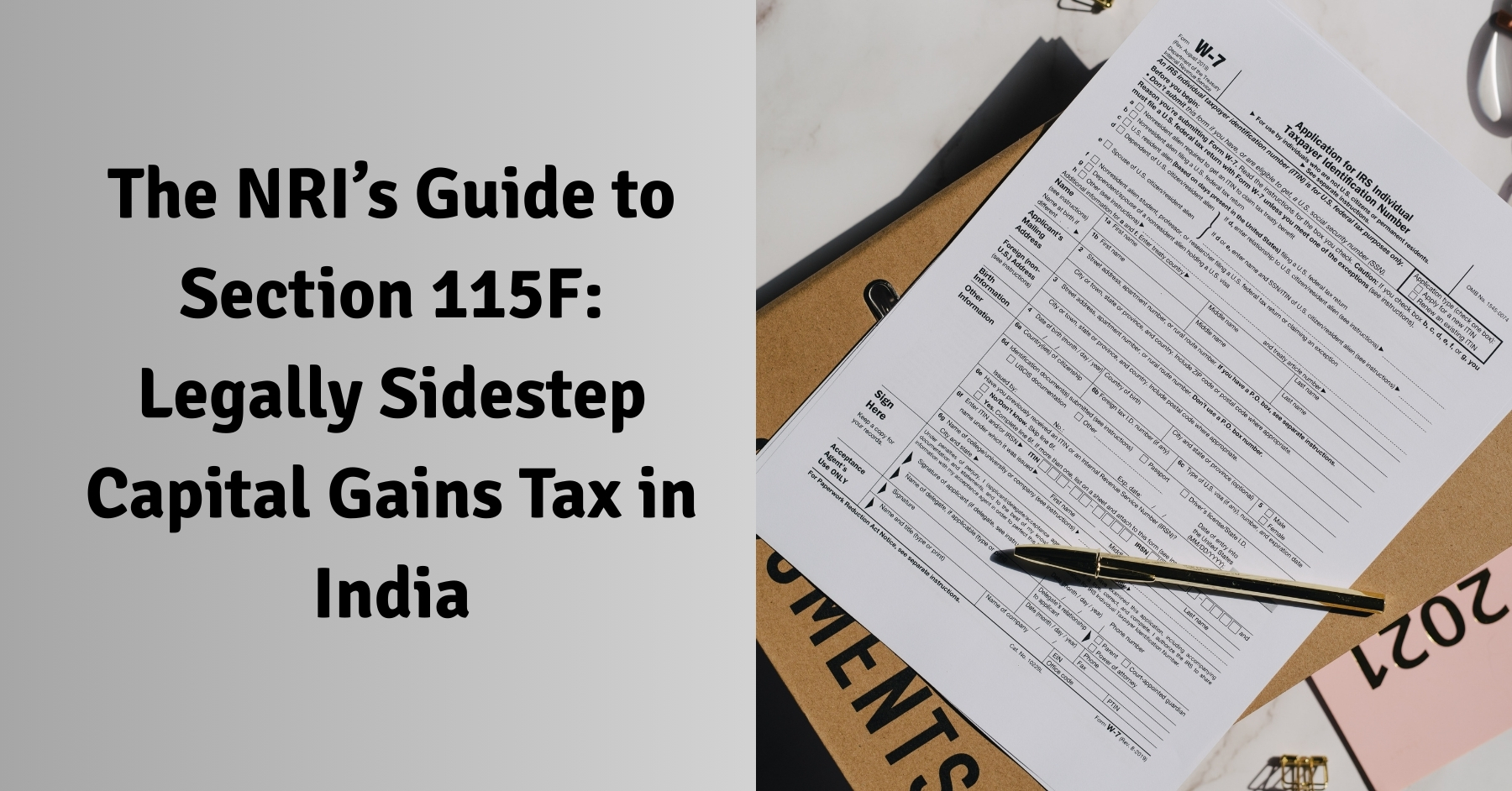The NRI’s Guide to Section 115F: Legally Sidestep Capital Gains Tax in India

For many Non-Resident Indians (NRIs), investing in the Indian market is a powerful way to stay connected to the nation’s growth story and build wealth. However, the success of these investments often comes with a sting in the tail: capital gains tax. The moment you sell a profitable asset, the Indian Income Tax Act requires its share of your profit. But what if there was a legal, strategic way to defer or even completely avoid this tax liability?
There is, and it’s one of the most powerful yet underutilized tools in an NRI’s financial arsenal: Section 115F of the Indian Income Tax Act. This special provision is designed exclusively for NRIs, offering a legitimate pathway to protect your long-term capital gains from the taxman’s reach. However, this is not a simple loophole; it is a structured provision with strict rules and conditions. Understanding how to navigate it correctly can save you lakhs in taxes, while a misstep can nullify the benefit entirely. This guide will break down everything you need to know to leverage Section 115F effectively.
What Exactly is Section 115F and Who Can Use It?
At its core, Section 115F is a tax exemption provision created specifically for Non-Resident Indians. It states that if an NRI earns long-term capital gains from selling certain Indian financial assets, they can avoid paying tax on those gains, provided they reinvest the entire sale proceeds into other specified financial assets within a specific timeframe.
The first and most critical condition is your residential status: this provision is exclusively for NRIs. The moment you become a resident Indian, this benefit is no longer available to you for any new transactions.
Furthermore, the law is particular about the source of your original investment. To qualify for the exemption, the asset you are selling must be a “foreign exchange asset.” This means the original purchase must have been made using foreign currency, typically through a Non-Resident External (NRE) or Foreign Currency Non-Resident (FCNR) account. If you funded your initial investment from a Non-Resident Ordinary (NRO) account or a local Indian source, you cannot claim the benefit under Section 115F.
The Mechanics of the Tax Exemption: Timelines and Assets
Successfully using Section 115F requires a disciplined, step-by-step approach. The rules regarding the types of assets and the timelines are non-negotiable.
Eligible Assets for Sale and Reinvestment:
The provision is very specific about the assets that qualify. It is applicable only to financial assets. These include:
- Shares in an Indian company.
- Debentures issued by an Indian public limited company.
- Deposits with Indian banks and public companies.
- Central Government securities.
- Other notified securities (like National Savings Certificates).
One of the most common misconceptions relates to property. It is crucial to understand that real estate is explicitly excluded from this provision. You cannot sell a property and reinvest the proceeds under Section 115F to save on capital gains tax.
The Reinvestment Rule:
This is another area where many NRIs falter. Unlike some other tax-saving provisions where you only need to reinvest the capital gain amount, Section 115F mandates that you reinvest the entire net sale consideration. If you sell shares for ₹50 lakh, you must reinvest the full ₹50 lakh, not just the profit you made.
If you reinvest only a portion of the sale proceeds, you will receive a proportionate tax exemption. For instance, if you reinvest only 60% of the sale amount, you will only get an exemption on 60% of your capital gains, and the remaining 40% will be taxable.
The Six-Month Window:
The clock starts ticking the moment you sell your asset. You have a strict deadline of six months from the date of sale to make the new investment. There is no extension or grace period. Meticulous planning is key to ensuring you identify a suitable new investment and complete the transaction within this window.
The Golden Handcuffs: The 3-Year Lock-In Period
The tax benefits of Section 115F come with a significant condition: a lock-in period. The new financial asset you purchase must be held for a minimum of three years. This rule is in place to encourage long-term investment and prevent the provision from being used for short-term speculation.
If you sell or transfer the new asset before the three-year period is over, the tax exemption you previously claimed is revoked. The capital gain that was originally exempted will become taxable in the year you break the lock-in. Think of it as a set of “golden handcuffs”—you get the immediate benefit of tax exemption, but you are committed to holding the new investment for the medium term to retain that benefit.
A Crucial Distinction: Tax Deferral vs. Tax Forgiveness
It’s vital to understand that Section 115F is fundamentally a tax deferral scheme, not a tax forgiveness scheme. It doesn’t make your tax liability vanish into thin air; it simply pushes it down the road. The capital gain is not taxed at the time of the initial sale, but the liability remains dormant.
When this deferred tax might become payable depends on your future actions and residency status.
- If you sell the new asset after the three-year lock-in period is over (while you are still an NRI), you will have to calculate capital gains based on the new sale.
- If you become a resident of India and then sell the asset, the tax treatment will be subject to the rules applicable to residents.
- Your tax liability in your country of residence also plays a major role. The Double Taxation Avoidance Agreement (DTAA) between India and your country of residence will determine the final tax outcome.
This makes it essential to integrate your Indian tax planning with your global tax strategy.
Your Practical Checklist for Using Section 115F
To ensure you stay on the right side of the law and successfully claim your exemption, follow this checklist:
- Confirm Your Status: Are you an NRI for the relevant financial year?
- Verify the Source: Was the original investment made from an NRE or FCNR account?
- Check Asset Eligibility: Is the asset you are selling a qualifying financial asset (not real estate)?
- Confirm Gain Type: Is it a long-term capital gain? (Holding period for listed equity is over one year; for most other financial assets, it is over three years).
- Plan the Reinvestment: Are you prepared to reinvest the entire sale amount?
- Mark Your Calendar: Note the exact date of sale and set a reminder for the six-month deadline.
- Commit to the Lock-In: Are you willing to hold the new asset for at least three years?
- Seek Expert Advice: Consult with a tax professional who specializes in NRI taxation to review your plan.
Conclusion
Section 115F is an incredibly effective tool that allows NRIs to strategically manage their tax liabilities in India. It empowers you to roll over your investments and continue participating in the Indian growth story without being burdened by immediate tax outgo on your long-term gains. However, its power lies in its precise application. By understanding the strict conditions related to timelines, asset types, reinvestment amounts, and holding periods, you can confidently use this provision to optimize your financial returns and build lasting wealth. As always with complex tax matters, professional guidance is not just recommended; it’s essential for navigating the fine print and securing your financial advantage.
FAQs
- What is Section 115F in simple terms?
Ans- It is a tax provision exclusively for NRIs that allows them to avoid paying tax on long-term capital gains if they reinvest the full sale proceeds into other specified financial assets within six months.
- Can a Resident Indian use Section 115F?
Ans- No, this section is strictly for Non-Resident Indians.
- Can I use Section 115F for selling my apartment in India?
Ans- No, this provision does not apply to the sale of real estate. It is only for specified financial assets like shares and debentures.
- Do I need to reinvest only the profit or the entire sale amount?
Ans- You must reinvest the entire net sale consideration to get a full tax exemption.
- What is the time limit for making the new investment?
Ans- You must reinvest the proceeds within six months from the date of the sale of your original asset.
- What is the lock-in period for the new investment?
Ans- You must hold the new asset for a minimum of three years to retain the tax benefit.
- What happens if I sell the new asset after two years?
Ans- The capital gain that was previously exempted will become taxable in the year you sell the new asset.
- Does this exemption apply to short-term capital gains?
Ans- No, Section 115F is only applicable to long-term capital gains.
- What if my original investment was funded from my NRO account?
Ans- You cannot claim the exemption. The original investment must be a “foreign exchange asset,” typically funded from an NRE or FCNR account.
- Is the tax on my capital gain completely forgiven?
Ans- No, it is deferred. The tax liability may arise in the future when you sell the new asset, depending on your residency status and applicable tax treaties at that time.
Disclaimer: The information provided here is for educational and informational purposes only and should not be construed as financial, legal, or tax advice. Consult with a qualified professional before making any investment decisions. We do not accept any liability for errors or omissions in this information nor any direct, indirect, or consequential losses arising from its use.



